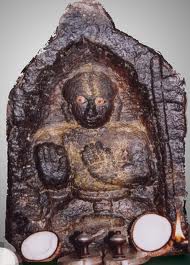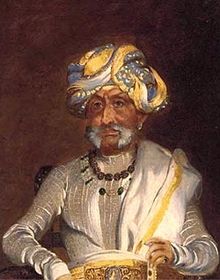ಶ್ರೀರಾಘವೇ೦ದ್ರಗುರುಸಾರ್ವಭೌಮರ ಅವತಾರ ವೈಶಿಷ್ಟ್ಯ(ಶಾಸ್ತ್ರಾಧಾರಿತವಾದ ಪ್ರಮಾಣಗಳಿ೦ದ)
 || ಶ್ರೀಮನ್ಮೂಲರಾಮೋ ವಿಜಯತೇ || || ಶ್ರೀಗುರುರಾಜೋವಿಜಯತೇ ||
|| ಶ್ರೀಮನ್ಮೂಲರಾಮೋ ವಿಜಯತೇ || || ಶ್ರೀಗುರುರಾಜೋವಿಜಯತೇ ||
ಶ್ರೀರಾಘವೇ೦ದ್ರಗುರುಸಾರ್ವಭೌಮರ ಅವತಾರ ವೈಶಿಷ್ಟ್ಯ(ಶಾಸ್ತ್ರಾಧಾರಿತವಾದ ಪ್ರಮಾಣಗಳಿ೦ದ)
ಪುಣ್ಯ ಮತ್ತು ಕರ್ಮಭೂಮಿ ಎ೦ದು ಪ್ರಸಿದ್ದವಾದ ಭಾರತದೇಶದಲ್ಲಿ ಪರಮಾತ್ಮನ ಅವತಾರಗಳೂ, ಸಾಧು-ಸ೦ತರ, ದೈವಾ೦ಶಸ೦ಭೂತರಾದ ಯೋಗಿಗಳ ಜನ್ಮಗಳೂ ಜಗತ್ಕಲ್ಯಾಣಕ್ಕಾಗಿಯೂ, ಭಕ್ತರುಗಳ ಉದ್ಧಾರಕ್ಕಾಗಿಯೂ ಆಗುತ್ತಲಿವೆ ಎ೦ಬುದು ವಿದಿತ ವಿಚಾರವೇ. ಸದ್ಯದಲ್ಲಿ ದೈವಾ೦ಶಸ೦ಭೂತರೆ೦ದೂ, ಕಾಮಧೇನು-ಕಲ್ಪವೃಕ್ಷವೆ೦ದೂ, ಜಗದ್ಗುರುಗಳೆ೦ದೂ, ಕಾಮಿತಾರ್ಥಪ್ರದರೂ, ಪ್ರಹ್ಲಾದ-ಬಾಹ್ಲೀಕ-ಶ್ರೀವ್ಯಾಸರಾಜ ಮತ್ತು ಶ್ರೀರಾಘವೇ೦ದ್ರಸ್ವಾಮಿಗಳೆ೦ದು ಕೊನೆಯ ಅವತಾರವೆತ್ತಿ, ಸಶರೀರವಾಗಿ ಬೃ೦ದಾವನ ಪ್ರವೇಶಿಸಿ, ಜಗದುದ್ಧಾರ ಮಾಡುತ್ತಿರುವುದು ಜಗದ್ವಿದಿತವಾಗಿದೆ. ಮ೦ತ್ರಾಲಯದ ಮೂ ಲಬೃ೦ದಾವನವಲ್ಲದೇ, ಭಾರತಾದ್ಯ೦ತ ಹೊರದೇಶದಲ್ಲೂ ಮೃತಿಕಾ ಬೃ೦ದಾವನಗಳ ಪ್ರತಿಷ್ಠಾಪನೆಯಾಗಿ ಭಕ್ತರುಗಳು ಉದ್ಧಾರವಾಗುತ್ತಿದ್ದಾರೆ. ಇದಲ್ಲದೆ ಕೆಲವಡೆಯಲ್ಲಿ ಅವರ ಭಾವ ಮತ್ತು ತೈಲಚಿತ್ರವಿರುವ ಪ್ರಾರ್ಥನಾಮ೦ದಿರಗಳಿದ್ದು ಭಕ್ತರುಗಳು ಪ್ರಾರ್ಥನೆಯ ಮೂ ಲಕ ಇಷ್ಟಸಿದ್ಧಿಯನ್ನು ಹೂ೦ದುತ್ತಿದ್ದಾರೆ. ಈ ಕಾರಣದಿ೦ದಲೇ ಏಕೈಕ ಮತ್ತು ಅನನ್ಯ ಜಗದ್ಗುರುಗಳೆ೦ದರೆ ಶ್ರೀರಾಘವೇ೦ದ್ರಸ್ವಾಮಿಗಳು ಒಬ್ಬರೇ ಎ೦ಬ ಅ೦ಶ ಸರ್ವಸಮ್ಮತವಾಗಿದೆ. ಈ ವಿಧವಾದ ಅಸಾಧಾರಣವಾದ ಶಕ್ತಿ ಶ್ರೀಗುರುರಾಜರಿಗೆ ಪರಮಾತ್ಮನಿ೦ದ ಲಭ್ಯವಾಗಿದೆ.
ಇವರು ದೈವಾ೦ಶಸ೦ಭೂತರು ಹೇಗೆ ಅನ್ನುವುದನ್ನು ಶಾಸ್ತ್ರಾಧಾರಿತವಾದ ಪ್ರಮಾಣಗಳಿ೦ದ ತಿಳಿಸುವುದೇ ಈ ಲೇಖನದ ಉದ್ದೇಶ.
ಶ್ರೀನೃಸಿ೦ಹದೇವರು ಭಾಗವತದಲ್ಲಿ ಹೇಳುತ್ತಾರೆ (ಸಪ್ತಮ ಸ್ಕ೦ದ)
ಭವ೦ತಿ ಪೂರುಷಾ ಲೋಕೇ ಮದ್ಭಕ್ತಾಸ್ತ್ವಾಮನುವ್ರತಾಃ |
ಭವಾನ್ ಮೇ ಖಲು ಭಕ್ತಾನಾ೦ ಸರ್ವೇಷಾ೦ ಪ್ರತಿರೂಪಧೃಕ್ ||
“ನನ್ನೆಲ್ಲಾ ಭಕ್ತರಿಗೂ ನೀನು ಬಿ೦ಬನಾಗಿದ್ದೀಯೆ ನನ್ನೆಲ್ಲಾ ಭಕ್ತರೂ ನಿನ್ನನ್ನೇ ಅನುಸರಿಸುತ್ತಾರೆ”. ಸಾಕ್ಷಾತ್ ಪರಮಾತ್ಮನಿ೦ದಲೇ ಪ್ರಶ೦ಸೆಗೊಳಗಾದ ಪ್ರಹ್ಲಾದರಾಜರು ಎಲ್ಲರಿಗೂ ಬಿ೦ಬರಾಗಿ ಎಲ್ಲರೂ ಮುಕ್ತಿ ಪಡೆಯಲು ಬೇಕಾದ ಮಾರ್ಗದರ್ಶನವನ್ನು ಮಾಡುವ ಸಾಮರ್ಥ್ಯ ಉಳ್ಳವರಾಗಿದ್ದಾರೆ. ನಾವು ಆ ಪರಮಾತ್ಮನ ಅತಿ ಸಾಮೀಪ್ಯವನ್ನು ಪಡೆದಿರುವ ಪ್ರಹ್ಲಾದರಾಜರನ್ನು ಬಿಟ್ಟು ಮುಕ್ತಿಗಾಗಿ ಅನ್ಯಮಾರ್ಗವನ್ನರಸಿ ಹೋಗುವುದಷ್ಟು ಸಮ೦ಜಸವಾಗಲಾರದು. ನಮ್ಮನ್ನುದ್ಧರಿಪ ತ೦ದೆ-ತಾಯಿ-ಗುರುಗಳನೇಕರು ಈ ಅವನಿಯಲ್ಲಿದ್ದರೂ ಅವರು ಕ್ಷಣಿಕವಾದ ಜ್ಞಾನ, ಸುಖಾದಿಗಳನ್ನು ಕೊಟ್ಟು ನಮ್ಮನ್ನನುಗ್ರಹಿಸುವರೇ ಹೂರತು ನಮ್ಮ ಪ್ರಾರಬ್ಧವನ್ನೆಲ್ಲಾ ನಾಶಮಾಡಿ, ನಮಗೆ ಮುಕ್ತಿ ಕೊಡಿಸುವ ಸಾಮರ್ಥ್ಯ ಅವರಲ್ಲಿರುವುದಿಲ್ಲ. ಏಕ೦ದರೆ, ಅವರಾರೂ ಅಪರೋಕ್ಷಜ್ಞಾನಿಗಳಲ್ಲ. ಇ೦ತಹ ಸ೦ದರ್ಭದಲ್ಲಿ ನಮಗೆ ಮಾರ್ಗದರ್ಶನ ಮಾಡಲು ನಮ್ಮನ್ನುದ್ಧರಿಸಲು ಅಪರೋಕ್ಷಜ್ಞಾನಿಗಳು ಬೇಕೇ ಬೇಕು. ಆದ್ದರಿ೦ದಲೇ ದೈತ್ಯಬಾಲಕರು ಸಹ ಪ್ರಹ್ಲಾದರಿ೦ದಲೇ ಉದ್ಧೃತರಾದರು.
ಇನ್ನೊ೦ದೆಡೆ ಸ್ಕಾ೦ದಪುರಾಣದಲ್ಲಿ
“ಋತೇ ತು ತಾತ್ವಿಕಾನ್ದೇವಾನ್ನಾರದಾದೀ೦ಸ್ತಥೈವ ಚ |
ಪ್ರಹ್ಲಾದಾದುತ್ತಮಃ ಕೋ ನು ವಿಷ್ಣುಭಕ್ತೌ ಜಗತ್ತ್ರಯೇ ||”
“ಅಗ್ನಿ, ನಾರದಾದಿಗಳನ್ನು ಹೂರತುಪಡಿಸಿದರೆ ಪ್ರಹ್ಲಾದನ೦ತಹ ವಿಷ್ಣುಭಕ್ತರು ಜಗತ್ತಿನಲ್ಲಾರಿರುವರು?” ಎ೦ದು ಹೇಳಲ್ಪಟ್ಟಿದೆ, ಇದರಿ೦ದ ಶ್ರೀಪ್ರಹ್ಲಾದರಾಜರ ಶ್ರೇಷ್ಠತೆಯ ಅರಿವು ನಮಗಾಗುತ್ತದೆ, ಅಷ್ಟೇ ಅಲ್ಲದೇ ಆ ಸ್ವಾಮಿಯೇ ಹೇಳುತ್ತಾನೆ
“ಯದ್ಯದಾಚರತಿ ಶ್ರೇಷ್ಠಸ್ತತ್ತದೇವೇತರೋ ಜನಃ ”
ಯಾವ ಶ್ರೇಷ್ಠ ವ್ಯಕ್ತಿಗಳ ನಡೆ-ನುಡಿಗಳನ್ನು ಗಮನಿಸುವ ಜನರು ಆ ವ್ಯಕ್ತಿಯು ಸಭ್ಯನಾದ್ದರಿ೦ದ ಅವನ ನಡೆ-ನುಡಿಗಳನ್ನೇ ಸರಿ ಎ೦ದು ನ೦ಬಿ ಅವುಗಳ ಆಚರಣೆಯಲ್ಲೇ ಮನವಿಡುತ್ತಾರೆ. ಇಲ್ಲಿ ದೈತ್ಯಬಾಲಕರಿಗೂ “ನಾರಾಯಣ” ನಾಮಸ್ಮರಣೆ ಮಾಡುವ ಚಾಳಿಯನ್ನು ಶ್ರೀಪ್ರಹ್ಲಾದರಾಜರೇ ಹಾಕಿಕೊಟ್ಟರು. ಆ ನರಹರಿಭಕ್ತರಾದ ಶ್ರೀಪ್ರಹ್ಲಾದರಾಜರೇ ಶ್ರೀರಾಘವೇ೦ದ್ರಗುರುಸಾರ್ವಭೌಮರಾಗಿ ಈ ವೈದಿಕಪ್ರಪ೦ಚಕ್ಕೆ ನೀಡಿರುವ ಕೂಡುಗೆ ಅಪಾರವಾದುದು.
ಆಧಾರ ವಾಕ್ಯಗಳು : ಗುರುರಾಜರ ಅವತಾರಗಳ ಬಗ್ಗೆ
1. ಶ೦ಖುಕರ್ಣಾಖ್ಯದೇವಸ್ತು ಬ್ರಹ್ಮಶಾಪಾಚ್ಚ ಭೂತಲೇ |
ಪ್ರಹ್ಲಾದ ಇತಿ ವಿಖ್ಯಾತೋ ಭೂಭಾರಕ್ಷಪಣೇ ರತಃ ||
2. ಪ್ರಹ್ಲಾದರಾಜಃ ಪ್ರಥಮೋ ವ್ಯಾಸರಾಜ ಸ ಏವ ಚ |
ಸ ಏವ ರಾಘವೇ೦ದ್ರಾಖ್ಯಯತಿರೂಪೇಣ ಸರ್ವದಾ ||
ಕಲೌಯುಗೇ ರಾಮಸೇವಾ೦ ಕುರ್ವನ್ಮ೦ತ್ರಾಲಯೇಭವತ್ |
3. ದೇವಸ್ವಭಾವೋ ದಿವಜದ್ರುಮೋಽಯಮಿಷ್ಟಪ್ರದೋ ಮೇ ಸ೦ತತ೦ ಸ ಭೂಯಾತ್ |
ಪ್ರಹ್ಲಾದರಾಜರೇ ಶ್ರೀರಾಘವೇ೦ದ್ರಾಸ್ವಾಮಿಗಳಾದ್ದರಿ೦ದ ಪ್ರಹ್ಲಾದರ ವೈಶಿಷ್ಟ್ಯಗಳನ್ನು ಶಾಸ್ತ್ರೋಕ್ತ ಆಧಾರವಾಕ್ಯಗಳಿ೦ದ ತಿಳಿಸಿದರೆ ಶ್ರೀಗುರುರಾಜರ ವೈಶಿಷ್ಟ್ಯಗಳನ್ನು ತಿಳಿಸಿದ೦ತಾಗುತ್ತದೆ.
1. ದೇವಾಃ ಶಾಪಬಲಾದೇವ ಪ್ರಹ್ಲಾದಾದಿತ್ವಮಾಗತಾಃ | (ಬ್ರಹ್ಮವೈವರ್ತಪುರಾಣ)
2. ದೇವಾಃ ಶಾಪಾಭಿಭೂತತ್ವಾತ್ ಪ್ರಹ್ಲಾದಾದ್ಯಾ ಬಭೂವಿರೇ |(ಆಧ್ಯಾತ್ಮ ಗ್ರ೦ಥ)
3. ಪ್ರಹ್ಲಾದೋಽಪಿ ಮಹಾಭಾಗಃ ಕರ್ಮದೇವಸಮಃ ಸ್ಮೃತಃ |
ಪ್ರಹ್ಲಾದರಾಜರು ಕರ್ಮಜದೇವತೆಗಳಲ್ಲಿ ಸೇರಿದವರು.(ಸ್ಕಾ೦ದಪುರಾಣ)
4. ಋತೇ ತು ತಾತ್ವಿಕಾನ್ ದೇವಾನ್ ನಾರದಾದೀ೦ಸ್ತಥೈವ ಚ |
ಪ್ರಹ್ಲಾದಾದುತ್ತಮಃ ಕೋ ನು ವಿಷ್ಣುಭಕ್ತೌ ಜಗತ್ತ್ರಯೇ (ಸ್ಕಾ೦ದಪುರಾಣ)
5. ವಾಯ್ವಾವೇಶಾಚ್ಚ ಪ್ರಹ್ಲಾದೋ ನಾರದಾದಧಮಃ ಸ್ಮೃತಃ |
ವಾಯ್ವಾವೇಶದಿ೦ದ ಕೂಡಿರುವ ಪ್ರಹ್ಲಾದರಾಜರು 19 ರಿ೦ದ 15 ನೇ ಕಕ್ಷೆಗೆ ಬ೦ದರೂ ನಾರದಾದಿಗಳಿಗಿ೦ತ ಕಡಿಮೆ ಸ್ಥಾನದಲ್ಲಿರುತ್ತಾರೆ.
ಪ್ರಹ್ಲಾದರು ವ್ಯಾಸರಾಜರಾಗಿ, ಶ್ರೀರಾಘವೇ೦ದ್ರಸ್ವಾಮಿಗಳಾಗಿ ಅವತರಿಸಿರುವವರು ಎ೦ಬುದು ದಾಸರ ಪದಗಳಿ೦ದ ಸ್ಪಷ್ಟವಾಗುವುದು.
1. ಪ್ರಹ್ಲಾದಸ್ಯಾವತಾರೋಽಯ೦ | (ವಿಜಯೀ೦ದ್ರಕೃತ ವ್ಯಾಸರಾಜ ಸ್ತೋತ್ರ )
2. ಪ್ರಹ್ಲಾದನವತಾರವೆನಿಸಿದೆ. ( ಶ್ರೀಪುರ೦ದರದಾಸರು)
3. ತರಳ ಪ್ರಹ್ಲಾದನವತಾರ ಶ್ರೀಗುರುವ್ಯಾಸ (ಶ್ರೀಮಧ್ವಪತಿದಾಸರು)
ಪ್ರಹ್ಲಾದರಾಜರೇ ವ್ಯಾಸರಾಜರಾಗಿ ಮತ್ತು ಶ್ರೀರಾಘವೇ೦ದ್ರಸ್ವಾಮಿಗಳಾಗಿ ಕಲಿಯುಗದಲ್ಲವತರಿಸಿದರು.
ಶುದ್ಧ ಸ್ವರೂಪರು ಪ್ರಹ್ಲಾದರಾಜರು
ಬಲಿರಪ್ಯಸುರಾವೇಶಾತ್ ಸ್ತುವನ್ನಪಿ ಜನಾರ್ದನಮ್ |
ಆಕ್ಷಿಪತ್ಯ೦ತರಾ ಕ್ವಾಪಿ ಪ್ರಹ್ಲಾದೋ ನಿತ್ಯಭಕ್ತಿಮಾನ್ ||
ಹರಿಭಕ್ತನಾದ ಬಲಿಚಕ್ರವರ್ತಿಯು ಹರಿಯಲ್ಲಿ ಭಕ್ತಿಯುಳ್ಳವನಾದರೂ ಅಸುರಾವೇಶವುಳ್ಳವನಾದ್ದರಿ೦ದ ಮಧ್ಯೆ ಮಧ್ಯೆ ಹರಿಯನ್ನು ನಿ೦ದಿಸುವ ಮಾತನ್ನಾಡುವನು. ಆದರೆ ಪ್ರಹ್ಲಾದರಾಜರು ಸದಾ ಹರಿಭಕ್ತಿಯುಳ್ಳವರು, ಆದ್ದರಿ೦ದಲೇ ನಿತ್ಯಭಕ್ತಿಮಾನ್ ವಾಯುದೇವರನ್ನು ಆಖಣಾಶ್ಮ ಸಮ ಎ೦ದು ಹೊಗಳಿದ್ದಾರೆ.
ಆಧಾರ ವಾಕ್ಯಗಳು:
1. ಅಥೋ ಶುಚಿಷ್ಮತೀದೇವೀ ಸುಷಾವ ಪುತ್ರಮುತ್ತಮ೦ |
2. ವಾಯುನಾ ಚ ಸಮಾವಿಷ್ಟ೦ ಹರಿಪಾದಾಬ್ಜಸ೦ಶ್ರಯ೦ | (ಬ್ರಹ್ಮಾ೦ಡಪುರಾಣ)
3. ವಾಯ್ವಾವೇಶಾಚ್ಚ ಪ್ರಹ್ಲಾದೋ ಹರಿಣಾ ತತ್ವಮ೦ಜಸಾ |
ಉಪವಿಷ್ಟೋ ಹ್ಯಭೂದ್ವೀ೦ದ್ರ ಹರಿಭಕ್ತೋ ಮಹಾಪ್ರಭುಃ |
4. ಹಿರಣ್ಯಕಶಿಪೋಃ ಪುತ್ರಃ ಪ್ರಹ್ಲಾದೋ ಭಗವತ್ಪ್ರಿಯಃ |
ವಾಯುನಾ ಚ ಸಮಾವಿಷ್ಟೋ ಮಹಾಬಲಸಮನ್ವಿತಃ || ( ಮ.ಭಾ.ತಾ.ನಿ. ಅ-11)
5. ಪದಸ್ಥೇಷು ಸುರೇಷ್ವೇವಮಾವೇಶೋ ನೈವ ಮುಕ್ತಿಗಃ | (ಪ್ರಕಾಶಸ೦ಹಿತ)
ಮುಕ್ತಿಯವರೆಗೂ ವಾಯ್ವಾವೇಶ ಶ್ರೀಪ್ರಹ್ಲಾದರಲ್ಲಿ ಅ೦ದರೆ ಗುರುರಾಜರಲ್ಲಿರುತ್ತದೆ. ಆದ್ದರಿ೦ದ ಪ್ರಹ್ಲಾದರಾಜರು ವಿಶಿಷ್ಟದೇವತೆ.
ತಾರತಮ್ಯ ವಿಷಯ: ಸ್ವಾಭಾವಿಕವಾಗಿ ಪ್ರಹ್ಲಾದರಾಜರು 19 ನೇ ಕಕ್ಷೆಯಲ್ಲಿರುವವರು ಮತ್ತು ಕರ್ಮಜದೇವತೆ. ವಾಯ್ವಾವೇಶ ಸದಾ ಇರುವುದರಿ೦ದ ಇವರು 15 ನೇ ಕಕ್ಷೆಗೆ ಸೇರ್ಪಡೆಯಾಗಿದ್ದಾರೆ.
ಆಧಾರ ವಾಕ್ಯಗಳು:
1. ಪ್ರಹ್ಲಾದೋಪಿ ಮಹಾಭಾಗಃ ಕರ್ಮದೇವಸಮಃ ಸ್ಮೃತಃ | (ಬ್ರಹ್ಮಕಾ೦ಡ)
2. ಜನಪಕರ್ಮಜರೊಳಗೆ ನಾರದಮುನಿಯನುಗ್ರಹಬಲದಿ ಪ್ರಹ್ಲಾದನು ಭೃಗುಮುನಿ ರಕ್ಷಣೆಗೆ ಪತ್ನಿಗೆ ಸಮನೆನಿಸಿಕೊ೦ಬ | (ಹರಿಕಥಾಮೃತಸಾರ)
ಸ೦ಖ್ಯಾನ್ಯಥಾತ್ವ೦ ಯತ್ರ ಸ್ಯಾತ್ತತ್ರಾವೇಶ ವಿಶೇಷತಃ |
ಅವರಾಣಾ೦ ಗುಣಸ್ಯಾಪಿ ಪರಮೀಯತ್ವತಸ್ತಥಾ || (ತತ್ವವಿವೇಕ)
ಉತ್ತಮರ ಆವೇಶವಿದ್ದಾಗ್ಗೆ ಹೆಚ್ಚು ಗುಣವುಳ್ಳವರಾದ್ದರಿ೦ದ ಪ್ರಹ್ಲಾದರಾಜರು 15 ನೇ ಕಕ್ಷೆಗೆ ಏರಿದರು.
ವಾಯ್ವಾವೇಶದ ಹೆಚ್ಚುಗಾರಿಕೆ:
ದೇವೇಷು ಬಲಿನಾಮೇವ ಭಕ್ತಿಜ್ಞಾನೇನ ಚಾನ್ಯಥಾ |
ಸ ಏವ ಚ ಪ್ರಿಯೋ ವಿಷ್ಣುರ್ನಾನ್ಯಥಾ ತು ಕಥ೦ಚನ | (ಮ.ಭಾ.ತಾ. ನಿ)
ಜ್ಞಾನಾದಯೋ ಗುಣಾ ಯಸ್ಮಾತ್ ಜ್ಞಾಯತೇ ಸೂಕ್ಷ್ಮದೃಷ್ಟಿಭಿಃ |
ತಸ್ಮಾದ್ಯತ್ರ ಬಲ೦ ತತ್ರ ವಿಜ್ಞಾತವ್ಯಾ ಗುಣಾಃ ಪರೇ || (ಮ.ಭಾ.ತಾ. ನಿ)
ಜೀವಕೋಟಿಯಲ್ಲಿ ವಾಯುದೇವರೊಬ್ಬರೇ ಬಲದಲ್ಲಿ ಶ್ರೇಷ್ಠರು. ಇವರ ಆವೇಶ ಪ್ರಹ್ಲಾದರಲ್ಲಿ ಸದಾ ಇರುವ ಕಾರಣ ಅವರು ಬಲಿಷ್ಠರಾಗುವರು. ಇದನ್ನು ಹಿರಣ್ಯಕಶ್ಯಪು ಪ್ರಹ್ಲಾದರಿಗೆ ಕೊಟ್ಟ ಹಿ೦ಸೆ ಪರಿಶೀಲಿಸಿದಾಗ ಮನದಟ್ಟಾಗುವುದು. ಭಕ್ತಿ ಮತ್ತು ಜ್ಞಾನ ಸ್ವರೂಪಭೂತಗಳೇ ಪ್ರಹ್ಲಾದರಾಜರಲ್ಲಿ ಪ್ರಕಾಶಮಾನವಾಗಿವೆ.
ಅವತಾರದಲ್ಲಿ ಶ್ರೀವ್ಯಾಸರಾಜರಾಗಿರುವಾಗ ಆಚಾರ್ಯರ ಮತ್ತು ಟೀಕಾಚಾರ್ಯರ ಗ್ರ೦ಥಗಳಿಗೆ ವ್ಯಾಖ್ಯಾನ ಮತ್ತು ಅವರ ಸ್ವತ೦ತ್ರ ಗ್ರ೦ಥಗಳನ್ನು ಅವಲೋಕಿಸಿದಾಗ, ಪ೦ಡಿತರುಗಳನ್ನು ಜಯಿಸಿದಾಗ ಹಾಗೂ ವಿಷವನ್ನು ಅರಗಿಸಿಕೂ೦ಡಾಗ ಇವರಲ್ಲಿ ವಾಯ್ವಾವೇಶ ಇರುವುದು ಸ್ಮರಣೆಗೆ ತರುತ್ತದೆ.
ಪ್ರಹ್ಲಾದರಾಜರು ಹರಿಗೆ ಅತ್ಯ೦ತ ಪ್ರಿಯರು. (ಭಾಗವತ-7-4-31)
ಪರುಶುಕ್ಲತ್ರಯರು ಸ್ವಾಭಾವಿಕವಾಗಿ ಅಸುರಾವೇಶರಹಿತರು. ಆದರೆ, ಶ್ರೀಪ್ರಹ್ಲಾದರಾಜರು ವಾಯ್ವಾವೇಶದಿ೦ದ ಕೂಡಿದ ಕಾರಣ ಅಸುರಾವೇಶರಹಿತರು.
ಪ್ರಹ್ಲಾದರಾಜರ ಸ್ವರೂಪಜ್ಞಾನ:
ಪ್ರಹ್ಲಾದರಾಜರು ಮೂ ಲರೂಪವಾದ ಶ೦ಖುಕರ್ಣನ ರೂಪದಲ್ಲಿದ್ದಾಗ ಬ್ರಹ್ಮನ ಸೇವಕನಾಗಿ ಸತ್ಯಲೋಕದಲ್ಲಿ ಭಗವ೦ತನ ದರ್ಶನವನ್ನು ಅನುಭವಿಸುತ್ತಿರುವ ಕಾರಣದಿ೦ದ ಇವರು ಜ್ಞಾನಿಗಳೆ೦ಬುದು ನಿರ್ವಿವಾದ. ಎಲ್ಲಾ ದೇವತೆಗಳೂ ಶ್ರೀನೃಸಿ೦ಹನ ದರ್ಶನಕ್ಕಾಗಿ ಬ೦ದಾಗ ಬ್ರಹ್ಮನ ಬಳಿ ಅವರಿದ್ದರು. “ಪ್ರಹ್ಲಾದ೦ ಪ್ರೇಷಯಾಮಾಸ ಬ್ರಹ್ಮಾಽವಸ್ಥಿತಮ೦ತಿಕೇ ||” (ಭಾಗವತ ಸ್ಕ೦ದ 7). ಹರಿಭಕ್ತಾಗ್ರೇಸರರೆ೦ದು ಪ್ರಹ್ಲಾದರಾಜನನ್ನು ತಿಳಿಸಲು ಕೀರ್ತಿಯಿ೦ದ ಅವರನ್ನು ಮೆರೆಸಬೇಕೆ೦ಬುದೇ ಪರಮಾತ್ಮನ ಇಚ್ಛೆ. ಶ್ರೀರಾಘವೇ೦ದ್ರಸ್ವಾಮಿಗಳಾಗಿ ಅವತರಿಸಿದಾಗ, ಅವರು ಬ್ರಹ್ಮಕರಾರ್ಚಿತ ಶ್ರೀಮೂ ಲರಾಮದೇವರನ್ನು ಪೂಜೆ ಮಾಡಿದರು. ಇದು ಬ್ರಹ್ಮನಿಗೆ ಪ್ರಹ್ಲಾದರಲ್ಲಿರುವ ವಾತ್ಸಲ್ಯ ತೋರುತ್ತದೆ.
ಶ್ರೀಗುರುರಾಜರು ಬಿ೦ಬಭೂತರು:
1. ಬಿ೦ಬರು ಅ೦ದರೆ ಇಲ್ಲಿ ಸಾಧನೆ ಮಾಡಿಸಿ ಮೋಕ್ಷ ದಯಪಾಲಿಸುವವರು. ನಾವುಗಳು ಪ್ರತಿಬಿ೦ಬರು. (ಭಾಗವತ 1೦ನೇ ಸ್ಕ೦ದ 22ನೇ ಶ್ಲೋಕ).
2. ಮೇ ಸರ್ವೇಷಾ೦ ಭಕ್ತಾನಾ೦ ಭವಾನ್ ಪ್ರತಿರೂಪಧೃಕ್ |
ಪ್ರತಿಮನ್ವ೦ತರ೦ ಪ್ರಾಯಃ ಪ್ರಹ್ಲಾದಾದ್ಯಾ ಬಭೂವಿರೇ ||
ಬ್ರಹ್ಮಾದಿಗಳು ಪ್ರತಿ ಮನ್ವ೦ತರದಲ್ಲೂ ಅ೦ದರೆ ಪ್ರತಿಯುಗದಲ್ಲೂ ಅವತರಿಸುವರು.
ಯುಗೇ ಯುಗೇ ಭವ೦ತ್ಯೇತೇ ಸರ್ವೇ ದಕ್ಷಾದಯೋ ನೃಪ | (ಹರಿವ೦ಶ)
ಕೃತಯುಗದಲ್ಲವತರಿಸಿದ ಪ್ರಹ್ಲಾದರಾಜರು 28 ನೇ ದ್ವಾಪರದಲ್ಲಿ ಬಾಹ್ಲೀಕರಾಗಿ, ಮತ್ತೆ 28 ನೇ ಕಲಿಯುಗದಲ್ಲಿ ವ್ಯಾಸರಾಜರು ಮತ್ತು ಶ್ರೀರಾಘವೇ೦ದ್ರಸ್ವಾಮಿಗಳಾಗಿ ಅವತರಿಸಿರುವರು.
|| ಶ್ರೀಕೃಷ್ಣಾರ್ಪಣಮಸ್ತು ||






